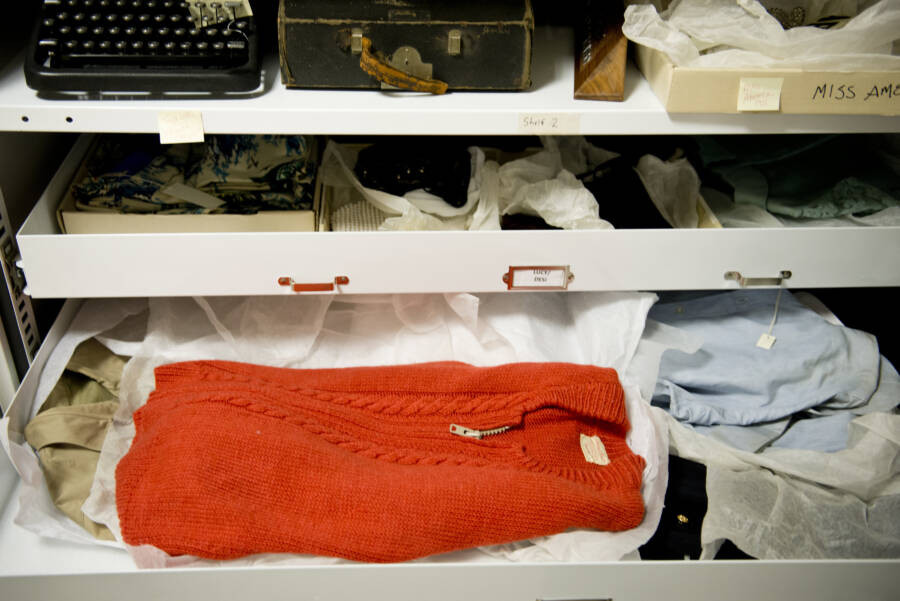Mr. Rogers tattoos are a persistent myth, despite lacking any factual basis. Tattooat.com explores the truth behind this urban legend, separating fact from fiction regarding the beloved children’s television host and dispelling any misconceptions about his personal life, his tattoos, and hidden ink. Discover the real reasons behind his iconic long-sleeved sweaters and his wholesome image.
1. Did Mr. Rogers Actually Have Tattoos?
No, Mr. Rogers did not have any tattoos. Despite rumors circulating for years, there’s no evidence to support the claim that Fred Rogers, the gentle host of Mister Rogers’ Neighborhood, had any ink on his body. The rumors likely started because he consistently wore long-sleeved sweaters, leading some to speculate he was hiding something.
Why Did the Tattoo Rumors About Mr. Rogers Start?
The rumors surrounding Mr. Rogers’ tattoos and supposed military past seem to stem from the contrast between his gentle television persona and the idea of someone with a hidden, tougher side. The rumors are an urban legend. As folklore expert Trevor J. Blank told The History Channel, the idea of the “Puritan-esque” Mr. Rogers having a “macho backstory” is “titillating” because “it runs counter to what you’re presented as true in your day-to-day experience.”
2. What Fueled the Mr. Rogers Tattoo Rumors?
The primary reason for the rumors was Mr. Rogers’ consistent choice of wearing long-sleeved sweaters on his show. This led some to assume he was concealing tattoos, potentially from a supposed past military service. A chain email that circulated in 2003 further fueled this myth, falsely claiming he was a Navy SEAL with numerous confirmed kills and tattoos to cover them.
The Infamous Chain Email and its Impact
The email described Mr. Rogers as a “U.S. Navy Seal, combat-proven in Vietnam with over twenty-five confirmed kills.” It claimed he wore long-sleeved sweaters to hide “the many tattoos on his forearm and biceps” and was “a master in small arms and hand-to-hand combat.” This fabricated story gained so much traction that the U.S. Navy had to issue a formal correction.
3. What Was the U.S. Navy’s Response to the Mr. Rogers Tattoo Rumors?
The U.S. Navy debunked the rumors, stating that Mr. Rogers was too old to enlist during the Vietnam War and that he went straight from college into television work. They also addressed the sweater issue, stating that he wore long-sleeved clothing to maintain formality and authority with both children and their parents.
Why Didn’t Mr. Rogers Serve in the Military?
Mr. Rogers, born in 1928, pursued higher education immediately after high school, earning a degree in music from Rollins College in 1951. He then embarked on a career in broadcasting, leaving no time for military service.
4. Why Did Mr. Rogers Wear Long-Sleeved Sweaters?
Mr. Rogers wore long-sleeved sweaters for several heartfelt reasons:
- His Mother’s Gift: His mother, Nancy Rogers, knitted many of his cardigans by hand, and he wore them to honor her.
- Professionalism: The sweaters were part of his persona, helping him maintain a formal and authoritative relationship with children, similar to a teacher.
- Comfort: He wanted to be comfortable while interacting with children and not feel restricted by a stiff jacket.
The Symbolism of Mr. Rogers’ Sweaters
The sweaters became an iconic part of Mr. Rogers’ image, symbolizing warmth, comfort, and approachability. They represented his commitment to creating a safe and welcoming environment for children.
 Mister Rogers Sweater on Display
Mister Rogers Sweater on Display
5. How Did Mr. Rogers Respond to the Rumors?
While Mr. Rogers never directly addressed the tattoo rumors, those who knew him well found them amusing. Neighborhood stage manager Nick Tallo humorously stated, “He didn’t know how to use a screwdriver, let alone kill a bunch of people.”
Insights from Those Who Knew Him
Those who worked with Mr. Rogers consistently describe him as a gentle, kind, and compassionate man, further discrediting the rumors of a secret, violent past.
6. What Was Mr. Rogers’ True Background and Values?
Born on March 20, 1928, in Latrobe, Pennsylvania, Fred Rogers graduated magna cum laude from Rollins College with a degree in music. He was a talented composer and pianist, writing over 200 songs for his children’s program. He was also an ordained Presbyterian minister who promoted inclusion, tolerance, and self-acceptance, famously saying, “God loves you just the way you are.”
Mr. Rogers’ Dedication to Children’s Education
From 1968 to 2001, Mr. Rogers dedicated his life to educating and enlightening children through Mister Rogers’ Neighborhood. His show addressed important social and emotional issues, teaching children about kindness, empathy, and self-worth.
7. Why Do Urban Legends Like the Mr. Rogers Tattoo Story Persist?
Urban legends often thrive because they tap into our desire for the unexpected or the sensational. The Mr. Rogers tattoo story is compelling because it contrasts sharply with his public image. These stories often focus on issues of morality and challenge our perceptions of well-known figures.
The Psychology Behind Urban Legends
Folklore experts suggest that urban legends provide a way to explore anxieties and uncertainties in a safe, indirect manner. They often serve as cautionary tales or reflect cultural beliefs and values.
8. What Is Mr. Rogers’ Legacy?
Mr. Rogers’ legacy is one of kindness, compassion, and unwavering dedication to children’s well-being. He remains an icon of American culture, admired for his gentle demeanor, his commitment to education, and his ability to connect with people of all ages.
Mr. Rogers’ Enduring Impact
Even after his death on February 27, 2003, Mr. Rogers continues to inspire generations with his timeless messages of love, acceptance, and respect.
 Mr. Rogers Puppets
Mr. Rogers Puppets
9. What Can We Learn From the Mr. Rogers Tattoo Rumors?
The Mr. Rogers tattoo rumors serve as a reminder to be critical of the information we encounter, especially online. It highlights the ease with which misinformation can spread and the importance of verifying facts before accepting them as truth.
The Importance of Critical Thinking
In an age of fake news and social media, it’s crucial to develop critical thinking skills to evaluate sources and identify false or misleading information.
10. Where Can I Find Reliable Information About Tattoo History and Culture?
For accurate and insightful information about tattoo history, tattoo culture, and tattoo designs, visit Tattooat.com. We offer a wide range of articles, artist profiles, and design galleries to inspire and inform your tattoo journey.
Discover Tattoo Artistry and Inspiration at Tattooat.com
Explore our extensive collection of tattoo designs, find talented artists in your area, and learn about the rich history and cultural significance of tattooing.
Exploring the Art of Tattooing: Beyond the Myths
While the Mr. Rogers tattoo story is a myth, the world of tattooing is rich with history, artistry, and personal expression. From traditional designs to modern masterpieces, tattoos offer a unique way to tell your story and celebrate your individuality.
Tattoo Styles and Their Meanings
Different tattoo styles have evolved over centuries, each with its own distinct characteristics and cultural significance. Some popular styles include:
- Traditional American: Bold outlines, classic imagery, and vibrant colors.
- Japanese: Intricate designs often depicting mythological creatures, landscapes, and folklore.
- Tribal: Geometric patterns and symbolic representations of ancestral heritage.
- Realism: Highly detailed and lifelike depictions of portraits, landscapes, and objects.
- Watercolor: Soft, flowing colors that mimic the look of watercolor paintings.
Choosing the Right Tattoo Artist
Finding a skilled and reputable tattoo artist is essential for a positive and safe experience. Consider the following factors when selecting an artist:
- Portfolio: Review the artist’s portfolio to assess their skill, style, and attention to detail.
- Hygiene: Ensure the studio follows strict hygiene practices, including sterilization of equipment and use of disposable needles.
- Consultation: Schedule a consultation to discuss your design ideas, placement, and any concerns you may have.
- Reputation: Read reviews and ask for recommendations from trusted sources.
Tattoo Aftercare: Protecting Your Investment
Proper aftercare is crucial for ensuring your tattoo heals correctly and maintains its vibrancy. Follow your artist’s instructions carefully, which may include:
- Keeping the tattoo clean: Gently wash the tattoo with mild soap and water.
- Applying a healing ointment: Use a recommended ointment to keep the tattoo moisturized and protected.
- Avoiding sun exposure: Protect the tattoo from direct sunlight to prevent fading.
- Avoiding swimming and soaking: Refrain from swimming or soaking in tubs until the tattoo is fully healed.
Tattooat.com: Your Guide to the World of Tattoos
At Tattooat.com, we’re passionate about providing you with the resources and information you need to navigate the exciting world of tattoos. Whether you’re looking for inspiration, guidance, or simply a deeper understanding of tattoo culture, we’re here to help.
Explore Our Resources
- Design Galleries: Browse thousands of tattoo designs across various styles and themes.
- Artist Directory: Find talented tattoo artists in your area.
- Informative Articles: Learn about tattoo history, styles, aftercare, and more.
- Community Forum: Connect with fellow tattoo enthusiasts and share your experiences.
Ready to Start Your Tattoo Journey?
Visit Tattooat.com today to explore the world of tattoos, find inspiration, and connect with talented artists. Discover the perfect design to express your individuality and create a lasting work of art. Don’t let myths and rumors hold you back – embrace the beauty and artistry of tattooing!
Explore tattoo design ideas, locate skilled artists, and deepen your understanding of tattoo artistry by visiting tattooat.com now! Let your creativity flow and turn your tattoo dreams into reality.
FAQ About Mr. Rogers and Tattoos
1. Was Mr. Rogers a Navy SEAL?
No, Mr. Rogers was not a Navy SEAL. This is a false rumor that has been circulating for years.
2. Did Mr. Rogers have any military experience?
No, Mr. Rogers did not serve in the military. He went straight from college into television work.
3. Why did Mr. Rogers always wear long-sleeved sweaters?
He wore them because his mother knitted them for him, to maintain formality on his show, and for comfort.
4. Did Mr. Rogers have any tattoos on his body?
No, there is no evidence to support the claim that Mr. Rogers had any tattoos.
5. Where did the Mr. Rogers tattoo rumors come from?
The rumors likely started because he always wore long-sleeved sweaters and people speculated he was hiding something.
6. How did the U.S. Navy respond to the Mr. Rogers rumors?
The Navy issued a formal correction, stating that Mr. Rogers was too old to enlist during the Vietnam War and that he went straight from college to television.
7. What were Mr. Rogers’ core values?
Mr. Rogers valued kindness, compassion, inclusion, and self-acceptance.
8. What was Mr. Rogers’ profession before television?
He graduated with a degree in music and was a talented composer and pianist.
9. How can I find accurate information about tattoos?
Visit tattooat.com for reliable information about tattoo history, styles, and artists.
10. What is the best way to care for a new tattoo?
Follow your artist’s aftercare instructions, which typically include keeping the tattoo clean, applying a healing ointment, and avoiding sun exposure and swimming.
